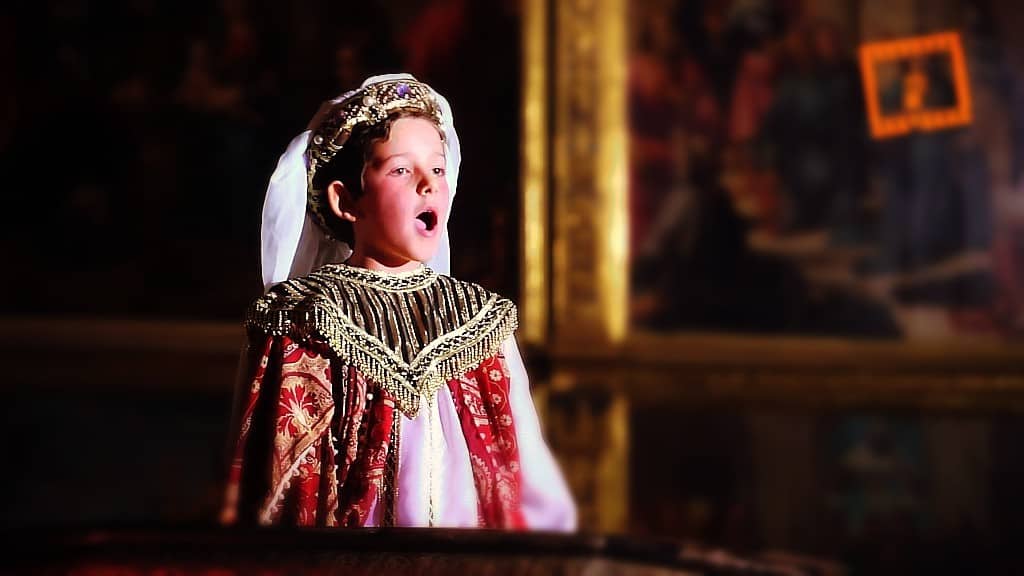The Song of the Sibyl, a tradition that intertwines the divine with the prophetic, has echoed through the centuries in various cathedrals and temples across Spain. Originally, the sibyls were seers in ancient Greece, whose influence spread to Rome, where they gained significant importance.
Integrating Ancient Wisdom into Modern Rituals: The Role of the Sibyl Today
Regarded as mouthpieces of the gods, these wise women were integrated into Christianity, adapting to a new religious context that directly linked them with the Final Judgment. In Spain, particularly in regions like Valencia and Catalonia, the Song of the Sibyl transformed into a paraliturgical spectacle that captured the essence of fear and reverence towards the divine.
This chant, once banned after the Council of Trent, has found renewed vigor in the 21st century, resonating anew in sacred places and being recognized as Intangible Cultural Heritage by UNESCO.
The significance of this resurgence lies not only in reviving a cultural practice but also in the profound symbolic and spiritual depth enclosed by the apocalyptic chant of the Sibyl, reaffirming its importance in both religious and cultural traditions in Spain.
The Sibyl: A Symbol of Tradition and Prophecy
More than just a melody, the Song of the Sibyl is a narrative loaded with prophetic and apocalyptic symbolism. At the heart of this cultural and religious phenomenon, the Sibyl stands as a figure transcending time and space, linking ancient pagan beliefs with Christianity.
Traditionally, the chant was performed in Latin, but over time it has been adapted into vernacular languages like Catalan, thus preserving its essence through local dialects.
This chant describes scenes from the Final Judgment, where figures such as Saint John the Baptist, Moses and other biblical and historical characters appear to testify to the truth of Sibyl’s omens.
Choosing a boy or girl to embody the Sibyl during performances was a deliberate decision, intended to emphasize purity and innocence necessary for conveying divine truths. Their message’s power lies in its ability to summon the community, using fear of the end times as a powerful tool for reflection and change.
Renewal of this tradition in cathedrals like Valencia’s and various temples in Mallorca and other Catalan-speaking enclaves not only rescues a nearly forgotten practice but also revitalizes its meaning, adapting the message to contemporary sensibilities without losing the connection to its historical and spiritual origins.
The Role of the Sibyl in Modern Culture
Impact of the Sibyl in contemporary culture is evident not only in its revival as a paraliturgical act but also in its influence on the cultural narrative of the region. UNESCO’s declaration recognizing the Song of the Sibyl as Intangible Cultural Heritage underscores its importance as a vital element of Spanish cultural identity.
Beyond its religious and historical functions, the Sibyl acts as a bridge between generations, allowing young people to connect with a legacy that encapsulates deep beliefs and values of their community.
In places like Valencia and Mallorca, where the roots of this tradition remain strong, the Sibyl has also sparked renewed interest in the arts and ancient music.
Music groups specializing in Renaissance and Baroque music, such as Capella de Ministrers, have played a crucial role in reconstructing and disseminating the original texts and melodies that once accompanied the Sibyl’s performances.
This revitalization not only attracts tourists and scholars of music and culture but also educates the local population about the richness of their own heritage.
This cultural phenomenon has served to reinforce regional identity and has provided a platform for discussing universally relevant themes, such as the end of times and human morality, present in the apocalyptic chant of this tradition.
The tradition’s ability to adapt and resonate in the modern context demonstrates its enduring relevance and its potential to continue inspiring future generations.
Conservation and Future Projection of the Tradition Today
Conserving the Song of the Sibyl involves not only keeping alive the melodies and lyrics that compose this tradition but also ensuring that new generations understand its significance and the relevance of its continuity.
Cultural institutions and music groups have collaborated in creating replicas of ancient instruments and in training young musicians in the singing and musical techniques of the era when the Sibyl was originally performed.
One of the challenges in conserving this tradition is the need to balance authenticity with accessibility. Efforts to make the Song of the Sibyl relevant to contemporary audiences often face the task of adapting texts and contexts to a diverse audience that may lack familiarity with the more traditional elements of the performance.
To address these challenges, initiatives have been promoted that include the digitalization of ancient manuscripts and recordings that can be globally accessible, thus ensuring that the legacy of the Sibyl transcends geographical and cultural barriers.
Moreover, the inclusion of this tradition in ancient music festivals and educational programs in schools and universities ensures that the Song of the Sibyl remains a source of inspiration and learning.
Looking towards the future, the Song of the Sibyl has the potential to act not only as a reminder of Spain’s cultural roots but also as a symbol of the universality of human concerns about existence and destiny. Its message, which has resonated through the centuries, will continue to be relevant as people keep seeking answers to life’s great questions.





